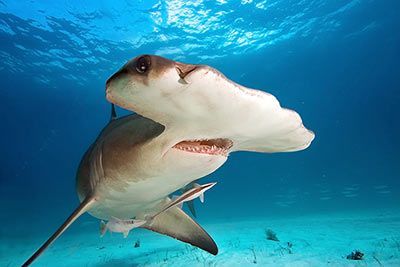Hammerhead Shark
Hammerhead Shark Facts
| Size | 36-240 in (92-610 cm) |
| Speed | Up to 25 mph (40 km/h) |
| Weight | 507-992 lb (230-450 kg) |
| Lifespan | 20-25 years |
| Food | Sardines, herrings, squids, rays |
| Predators | Tiger shark, white shark, orca |
| Habitat | Worldwide, coastal waters |
| Order | Ground sharks |
| Family | Hammerheads |
| Scientific name | Sphyrnidae |
| Characteristics | broad, flat head resembling a hammer |
Main Characteristics
The hammerhead shark has been named after the shape of its head, which resembles a hammer. There exist seven species. The great hammerhead and the smooth hammerhead are the biggest with a length of 20 feet (6.1 meters). At night it goes hunting on its own. During the day it swims about in so-called “schools” (groups) of up to 100 animals.
Anatomy and Appearance
Why Is the Head of This Shark Shaped Like a Hammer?
In the past, biologists reckoned that hammerheads used their heads to beat their prey to death. Today we know that the hammerhead can perceive its surroundings better due to the shape of its head. Its eyes are positioned left and right at the sides of the head so that the shark has a fantastic 360 degree view. With sensory pores at the snout the shark detects electrical signals from other living organisms. It can even easily detect rays hiding in the sands on the ground of the sea.

Life Style
Are All Sharks Loners?
Most sharks are solitary animals and normally swim about on their own. Hammerheads like to explore the oceans in groups. Smooth hammerheads and kidney-headed hammerheads even form schools of several hundred up to thousand animals.
Behavior
Is the Hammerhead Shark Dangerous?
Hammerheads are very big and often stay near the coast at 0 to 66 feet (0 to 20 meters) below the water surface. Yet, they can also dive up to 656 feet (200 meters) deep. Thus there happen to be encounters between bathing people and the impressive animals from time to time. Attacks occur very rarely, and only the great hammerhead is classified as dangerous. Two of 21 documented accidents with hammerheads were fatal.

Enemies and Threats
Do Hammerhead Sharks Have Enemies?
The biggest enemies of hammerhead sharks are humans. Hammerheads often drown in fishing nets. In some countries, their fins are even appreciated as a delicate dish, e.g. in the shark-fin soup.
Reproduction
Generally, the smaller hammerheads have two youngs and the larger ones more than 30. The babies are born in shallow waters and bred there for the first few years.

Species
How Big Can Hammerheads Get?
| Hammerhead Species | Maximum Length |
|---|---|
| Scalloped bonnethead | 3 feet (92 cm) |
| Scoophead | 5 feet (1.50 meters) |
| Bonnethead | 5 feet (1.50 meters) |
| Smalleye hammerhead | 5 feet (1.50 meters) |
| Scalloped hammerhead | 13.7 feet (4.20 meters) |
| Smooth hammerhead | 20 feet (6.10 meters) |
| Great hammerhead | 20 feet (6.10 meters) |













